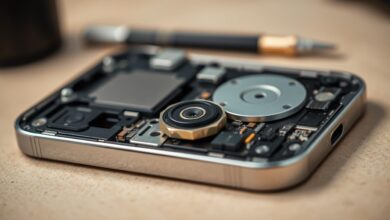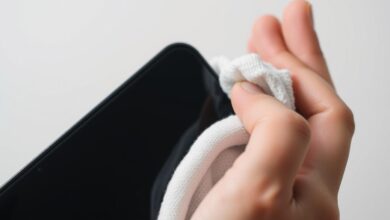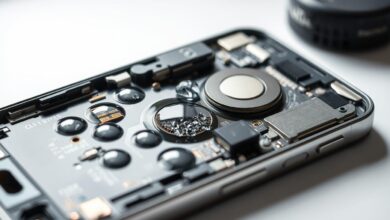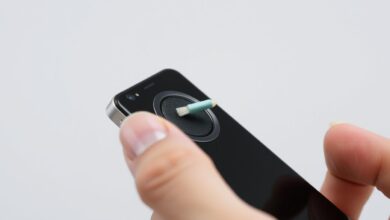how to clean iphone speaker
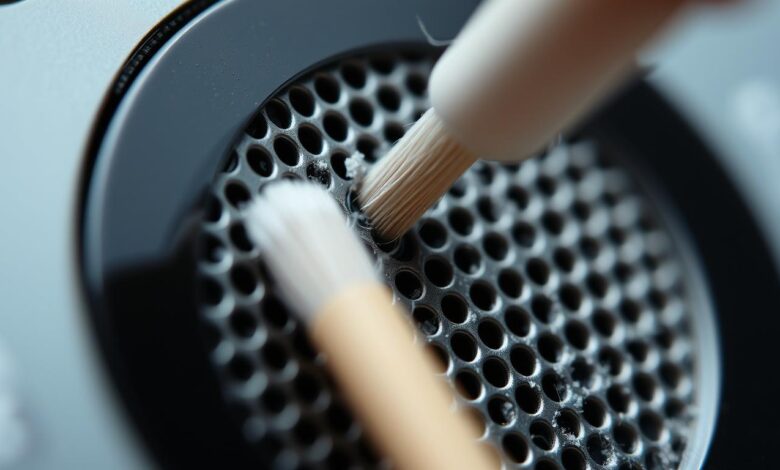
Is your iPhone’s sound quality not what it used to be? Dust and debris can easily clog your iPhone’s speaker, affecting its performance. Fortunately, cleaning your iPhone speaker is a simple process that can restore its audio quality.
I will guide you through the steps to safely clean your iPhone speaker. We’ll cover the necessary precautions, tools, and techniques. By following this guide, you can enhance your listening experience.
Key Takeaways
- Understand the importance of cleaning your iPhone speaker
- Learn the necessary precautions to avoid damaging your iPhone
- Discover the tools and techniques required for safe cleaning
- Follow step-by-step instructions to clean your iPhone speaker
- Improve your iPhone’s audio quality and overall listening experience
Understanding Your iPhone’s Speaker System
It’s important to know how your iPhone’s speaker system works. This system is key for sound during calls, music, and videos. Keeping it in good shape is essential.
Different Speaker Components on iPhones
iPhone speakers have several parts, like the speaker grill, driver, and enclosure. The speaker grill lets sound out. The driver turns electrical signals into sound. The enclosure boosts the sound.
| Component | Function |
|---|---|
| Speaker Grill | Allows sound to exit |
| Driver | Converts electrical signals into sound waves |
| Enclosure | Houses components and amplifies sound |
How Speakers Get Dirty Over Time
iPhone speakers can get dirty with time. Dirt, dust, and spills can harm them. This makes the sound quality worse.
Cleaning your iPhone speaker regularly is a good idea. It keeps the sound clear and the speaker working well. Knowing how the parts work helps you keep your speaker in great shape.
Signs Your iPhone Speaker Needs Cleaning
If your iPhone’s sound quality has dropped, it’s time to clean the speaker. Speakers can get dusty and dirty, which hurts the sound.
Muffled or Distorted Sound
A muffled or distorted sound means your speaker needs a clean. Dirt in the speaker grill stops sound from being clear. If your music or calls sound bad, it’s probably because of dirt.
Decreased Volume
Another sign is if your iPhone’s volume is too low. If you need to turn it up all the way to hear, it’s likely clogged. Cleaning it can fix this and make the volume right again.
No Sound Despite Volume Settings
At times, your iPhone won’t make sound even when the volume is high. This could mean there’s a big blockage in the speaker. Cleaning it is a smart first step before getting help from tech support.
| Signs | Description | Possible Cause |
|---|---|---|
| Muffled or Distorted Sound | Sound is unclear or fuzzy | Debris in speaker grill |
| Decreased Volume | Volume is lower than usual | Clogged speaker |
| No Sound | No sound output | Significant blockage or debris |
Precautions Before You Start Cleaning
Before you start cleaning your iPhone speaker, take some important steps. This ensures your device is cleaned safely and without damage.
Turning Off Your iPhone
First, turn off your iPhone. This step is key to avoid any accidental damage during cleaning. Press and hold the sleep/wake button until you see the “Slide to Power Off” slider. Then, slide it to the right to turn it off.
Removing Phone Case and Screen Protector
Next, take off your phone case and screen protector. This makes it easier to clean the speaker grills and other areas. It’s also a chance to clean your case and screen protector too, making sure your whole device is clean.
Gathering Necessary Cleaning Tools
Now, collect the cleaning tools you need. For cleaning your iPhone speaker, use a soft-bristled brush, compressed air, and a safe cleaning solution. Stay away from harsh chemicals or abrasive materials that could harm your iPhone. For tips on handling liquid spills, check out ifixit’s guide.
Here’s a quick overview of the precautions and tools you’ll need:
| Precaution | Description | Necessity Level |
|---|---|---|
| Turn Off iPhone | Prevents accidental activations or electrical surges | High |
| Remove Phone Case and Screen Protector | Gives better access to speaker grills and other areas | Medium |
| Gather Cleaning Tools | Ensures you have the right materials for safe cleaning | High |
Essential Tools for Cleaning iPhone Speakers
To clean your iPhone speaker, you’ll need some key tools. These tools are gentle but effective. Cleaning your speaker improves sound quality and extends your device’s life.
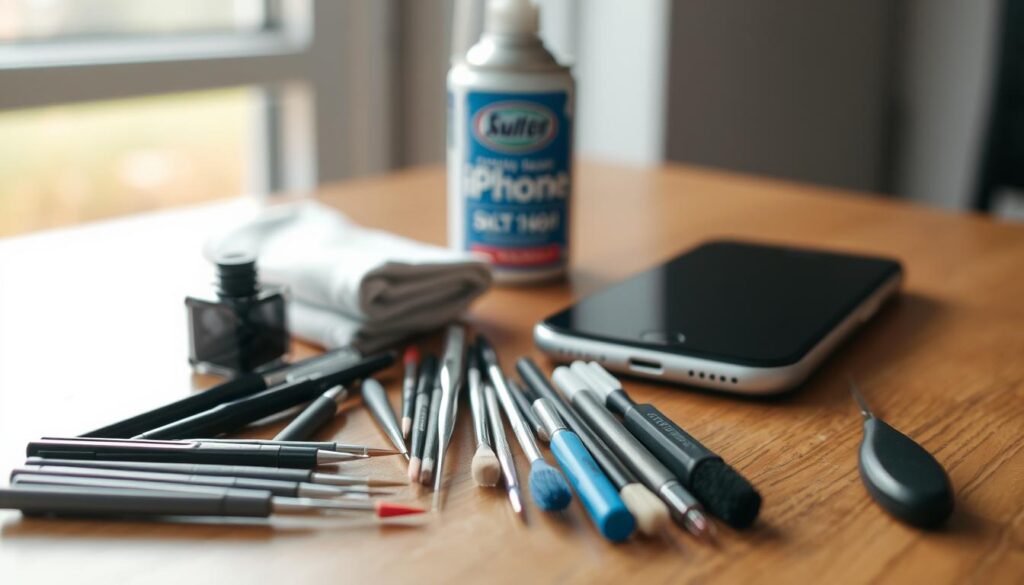
Safe Brushes and Tools
For DIY iPhone speaker cleaning, the right brushes and tools are crucial. A soft-bristled brush, like those for camera lenses or eyeglasses, is perfect. It gently removes debris from the speaker grills without harm.
- Use a small, dry brush to sweep away visible dust and lint.
- Opt for brushes with soft, flexible bristles that won’t scratch the speaker.
Compressed Air Options
Compressed air is also great for cleaning iPhone speakers. It helps dislodge dust and debris lodged deep in the speaker.
- Choose compressed air cans specifically designed for electronics.
- Use short, gentle bursts to avoid pushing debris further into the speaker.
Cleaning Solutions That Won’t Damage Your Device
For tough grime, a cleaning solution for iPhone speaker might be needed. But, it’s important to pick a safe solution for your device.
- Isopropyl alcohol (70% or higher) on a soft cloth can be effective, but avoid getting liquid into the speaker openings.
- Specialized electronic cleaning solutions are also available and can be a safe option.
How to Clean iPhone Speaker Using Dry Methods
There are several dry methods to clean your iPhone speaker at home. These methods are effective and easy to follow. They help keep your device’s sound quality high. Dry cleaning techniques are safe because they don’t damage your iPhone’s internal parts.
Using a Soft Brush Technique
One simple way to clean your iPhone speaker is with a soft-bristled brush. Gently sweep the brush across the speaker grills to remove dust or debris. This method is effective for removing loose particles that might affect your speaker’s sound quality.
Make sure the brush is soft enough not to scratch your iPhone. A small, dry paintbrush or a specialized electronics cleaning brush works well.
Compressed Air Method
Using compressed air is another dry method. Spray the compressed air gently across the speaker grills to dislodge dust or debris. Be careful not to spray too close to the speaker to avoid pushing debris further in.
It’s important to use compressed air designed for electronics to avoid damage.
Masking Tape Trick for Speaker Grill
The masking tape trick is a simple DIY method for removing stubborn debris from your iPhone speaker grills. Gently press a piece of masking tape over the grill and then lift it off. The tape can pick up dust and lint that other methods might miss.
Be gentle to avoid pushing debris further into the speaker. This method is particularly useful for removing lint and small particles that accumulate over time.
To summarize the dry cleaning methods, here’s a comparison table:
| Method | Effectiveness | Ease of Use |
|---|---|---|
| Soft Brush Technique | High | Easy |
| Compressed Air Method | Medium | Moderate |
| Masking Tape Trick | High | Easy |
By following these dry cleaning methods, you can effectively maintain your iPhone’s speaker. This ensures it continues to provide clear, high-quality sound.
Step-by-Step Guide: How to Clean iPhone Speaker Grills
iPhone speaker grills can get dirty, which can mess with your sound. But cleaning them is easy. Regular cleaning stops dust, dirt, and other stuff from blocking your iPhone’s sound.
Identifying Grill Locations on Different iPhone Models
First, find where the speaker grills are on your iPhone. They’re in different spots on different models. For most, they’re at the bottom and on the front, above the screen.
Some iPhones have them on the sides of the Lightning connector. Others have them only on the front or bottom. Check your iPhone manual or the manufacturer’s website to find out where they are on your model.
Gentle Brushing Techniques
After finding the grills, use a soft-bristled brush to clean them. A soft-bristled toothbrush or an electronics brush works well. Brush in one direction to avoid pushing dirt in.
This method safely removes loose dirt. It’s a good way to keep your iPhone’s speakers clean.
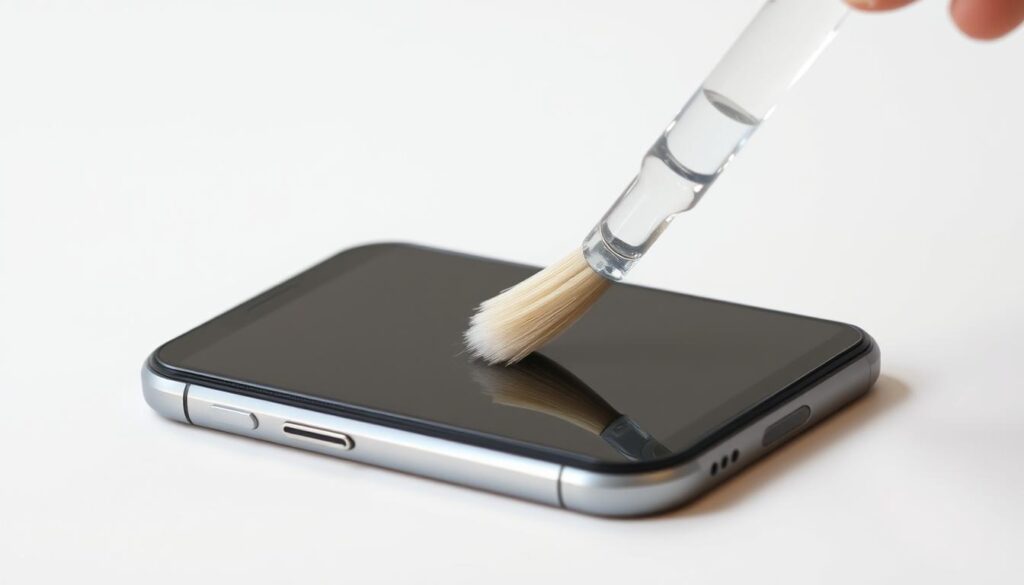
Removing Stubborn Debris from Grills
For tough dirt, you might need a stronger method. Use sticky tape or specialized cleaning putty to gently pull out stuck dirt. Don’t press too hard to avoid damaging the speakers.
If the dirt is really stuck, you might need to clean it a few times. This will get the grill clean.
As Apple recommends, cleaning regularly keeps your device working well. By following these steps, you can keep your iPhone’s speaker grills clean and sound quality high.
Using Specialized Tools for Speaker Cleaning
For a deep clean of your iPhone speaker, you need special tools. These tools help get rid of dirt and grime without harming your device. Let’s look at three important tools: anti-static brushes, cleaning putty/slime, and electronic cleaning tools.
Anti-static Brushes
Anti-static brushes are great for cleaning your iPhone’s speaker. They gently remove dust and debris without causing static damage. Choose a brush with soft bristles to avoid scratching the speaker grill. They work well for dust and lint in the speaker grills.
- Gently sweep the brush across the speaker grill to remove debris.
- Use a soft-bristled brush to avoid scratching the speaker.
Cleaning Putty/Slime
Cleaning putty, or slime, is another good tool for DIY iPhone speaker cleaning. It can be pressed into the speaker grill to pick up dust and debris. It’s a fun and easy way to clean hard-to-reach spots. Just remember to follow the manufacturer’s instructions and avoid pushing too hard to avoid damage.
Electronic Cleaning Tools
Electronic cleaning tools, like specialized kits, come with various tools for iPhone speaker maintenance. These kits might include brushes, cleaning solutions, and more. Make sure the tool is made for electronics and follow the manufacturer’s guidelines to avoid damage.
Using these specialized tools in your cleaning routine will help keep your iPhone speaker in top shape.
Safe Liquid Cleaning Methods for iPhone Speakers
Using liquids to clean iPhone speakers can be safe if done right. It’s best to avoid liquids to prevent damage. But, there are times when a liquid method is needed. Knowing the right way and precautions is key.
Isopropyl Alcohol Technique
Using isopropyl alcohol is a safe way to clean. Dampen a soft cloth with isopropyl alcohol, but don’t make it too wet. Wipe the speaker grills gently to remove dirt. The alcohol dries fast, lowering the risk of damage. But, don’t apply the alcohol directly to the speaker or into the openings.
Using Hydrogen Peroxide Safely
Hydrogen peroxide can also be used for cleaning, but with care. Mix hydrogen peroxide with water in a good ratio. Then, dampen a cloth with this mix. Clean the speaker area carefully. Make sure the solution is very diluted and avoid getting it into the iPhone’s openings.
When to Avoid Liquid Cleaning
There are times when you should avoid using liquid cleaning methods. If your iPhone has been wet recently, or if you’re not sure about the debris, dry cleaning is safer. Also, if your iPhone is still under warranty, using liquids could void it. It’s wise to check with the manufacturer or a professional.
| Cleaning Method | Safety Precautions | Effectiveness |
|---|---|---|
| Isopropyl Alcohol | Dampen a soft cloth, avoid direct application | Highly effective for removing dirt and debris |
| Hydrogen Peroxide | Mix with water, use a diluted solution | Effective but requires caution to avoid damage |
| Dry Methods | No liquid risk, safe for all situations | Effective for dry debris, less so for sticky residue |
Choosing a cleaning solution for your iPhone speaker is important. Always pick the safest option. If unsure, it’s best to ask a professional to avoid harming your device.
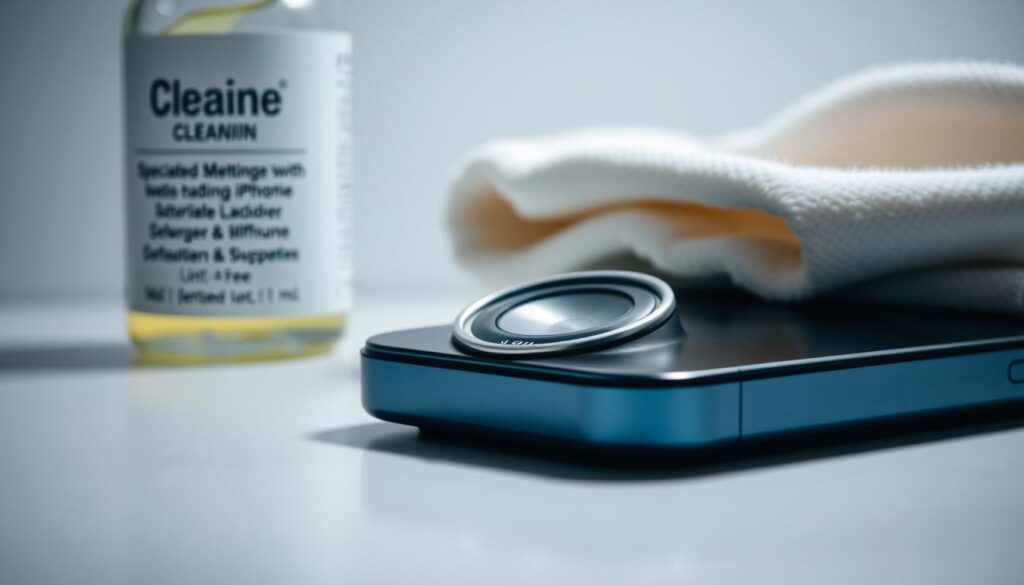
Removing Different Types of Debris from iPhone Speakers
To get your iPhone speaker working right, you need to figure out what’s blocking it. Different messes need different cleaning ways. The wrong method can harm your speaker.
Dealing with Dust and Lint
Dust and lint often block iPhone speakers. Use a soft-bristled brush or a dry cotton swab to clean. Gently move the brush or swab over the speaker grills to get rid of the mess.
For tough dust, try compressed air. But spray it upright and in short bursts. This helps avoid pushing the mess deeper into the speaker.
Removing Food Particles and Sticky Residue
Food and sticky stuff are hard to clean. First, try a dry method like a soft brush or compressed air to loosen big pieces. For sticky stuff, dampen a cotton swab with water but don’t soak it.
Wipe the sticky area with the damp swab. Then, use a dry swab to soak up any water left.
Tackling Makeup and Cosmetic Buildup
Makeup and cosmetics can leave tough residue. Use a cotton swab lightly dampened with isopropyl alcohol to clean. Be careful around sensitive areas.
After cleaning, use a dry cotton swab to get rid of any alcohol and residue left.
Knowing what’s blocking your iPhone speaker and how to clean it can help. This way, you can fix your speaker’s sound quality.
DIY Solutions for iPhone Speaker Maintenance
Using DIY methods for iPhone speaker care is both affordable and effective. Keeping your iPhone’s speaker in top shape is key for great sound. With a few easy steps, you can ensure your device sounds its best.
Homemade Cleaning Solutions
Making your own cleaning solutions is a smart way to care for your iPhone’s speaker. Mix equal parts water and white vinegar in a bowl. Use a soft-bristled toothbrush to gently brush away dirt from the speaker grills. The vinegar’s acidity helps dissolve dirt without harming your iPhone.
For another solution, mix baking soda and water to make a paste. Apply a small amount to a soft cloth and rub it on the speaker grills. The baking soda’s mild scrubbing action removes tough dirt. Then, use a dry part of the cloth to remove any leftover paste.
Household Items That Work as Cleaning Tools
Many household items can clean your iPhone speaker well. A soft-bristled toothbrush is great for dusting off the speaker grills. For tougher dirt, use a small piece of masking tape. Press it onto the grill and lift it off to clean.
Compressed air from a can also works to remove dust and debris. Hold the can upright and spray short bursts of air, keeping it a few inches from the speaker. This is good for getting rid of loose particles that can mess with sound quality.
Dealing with Water Damage in iPhone Speakers
When your iPhone gets wet, the speaker is at high risk. Water damage can cause sounds to be muffled or the speaker to stop working. It’s important to know how to fix water damage quickly to keep your iPhone working well.
Immediate Steps After Water Exposure
Act fast if your iPhone gets wet. First, turn it off to avoid short circuits. Then, take off any accessories like the SIM card and case to help it dry faster. Use a soft cloth to gently pat the outside dry, without rubbing too hard.
Using Sound Frequencies to Expel Water
Using sound frequencies can help get water out of your iPhone’s speaker. You can find videos online with the right sounds for this. Play these sounds softly to help push out the water without harming your device.
When to Seek Professional Help
If your iPhone still has speaker problems after trying to dry it and using sound frequencies, it’s time to get help. Go to an Apple Store or an authorized service provider. They can check your iPhone and fix or replace any damaged parts.
| Action | Description | Expected Outcome |
|---|---|---|
| Turn off iPhone | Immediately power off the device | Prevent short circuits |
| Dry the exterior | Gently pat dry with a soft cloth | Reduce water ingress |
| Use sound frequencies | Play specific tones to expel water | Remove water from speaker grills |
Fixing water damage in iPhone speakers needs quick action and the right steps. By knowing what to do first, using sound frequencies, and when to get professional help, you can fix water damage and keep your iPhone’s speaker working.
Preventative Measures to Keep Speakers Clean
By adopting simple habits, you can avoid deep speaker cleaning. Being proactive helps keep your iPhone’s speaker quality high. It also keeps your device running well.
Protective Cases That Don’t Block Speakers
Protective cases are great for shielding your iPhone from harm. But, make sure they don’t block the speakers. Choose cases with precise cutouts for clear sound. This stops debris from getting stuck in the speaker grills.
Regular Maintenance Schedule
Creating a regular maintenance routine is essential. Set aside time every few weeks to clean the speaker grills. A soft brush works well for dust and debris.
Regular cleaning keeps sound quality high. It also stops stubborn debris from building up.
Troubleshooting Common Issues After Cleaning
After cleaning your iPhone speaker, you might still face problems. These can affect how well your speaker sounds. Let’s look at some common issues and how to fix them.
Speaker Still Sounds Muffled
If your iPhone speaker sounds muffled after cleaning, there are a few things to check. First, make sure you’ve cleaned out all dirt and dust from the speaker grills. Sometimes, a second clean with a soft brush or compressed air can help.
If it still doesn’t work, it might be because of something inside that’s blocked or damaged. You might need to get help from a professional.
- Check for remaining debris in the speaker grills.
- Perform a second cleaning if necessary.
- Consider professional help if the issue remains.
Volume Problems Persist
If you’re still having trouble with volume after cleaning, check your settings. Make sure nothing is blocking the speaker. Also, try restarting your iPhone to fix any software problems.
If the problem doesn’t go away, it might be time to visit an Apple Store or an authorized service provider. They can help figure out what’s wrong.
- Verify that your volume settings are correctly adjusted.
- Restart your iPhone to resolve potential software issues.
- Seek professional assistance if the problem persists.
New Noises After Cleaning
If you notice new sounds like crackling or buzzing after cleaning, it’s a bit worrying. It could be because of the wrong cleaning methods or tools. Make sure you’re using the right way to clean your speaker to avoid damage.
If the sounds keep happening, it might mean there’s a hardware problem. You might need a professional to fix it.
To avoid these problems, always clean gently and use the right tools. Regular care can help keep your speaker working well and sounding great.
Conclusion
Cleaning your iPhone speaker is easy and can make a big difference in sound quality. Just follow the steps in this guide to get rid of dust and debris. This will help your speaker work better.
Keeping your iPhone speaker clean is key to its performance. Make cleaning a part of your phone care routine. This stops dust and debris from building up, keeping your sound clear and crisp.
Using the cleaning tips from this article will make your audio better and your device last longer. Whether you want better music or clearer calls, a clean speaker is crucial. Remember to clean your speaker regularly for the best sound.
FAQ
How often should I clean my iPhone speaker?
Clean your iPhone speaker every few months. Do it more often if sound quality drops or if your iPhone gets dirty.
Can I use a vacuum cleaner to clean my iPhone speaker?
No, don’t use a vacuum cleaner. It can harm your device with static electricity. Use a soft-bristled brush or compressed air instead.
What is the best way to clean my iPhone speaker at home?
Use a dry method like a soft-bristled brush or compressed air. You can also use an anti-static brush or cleaning putty for tough spots.
Can I use water to clean my iPhone speaker?
No, water can damage your iPhone’s inside. If you must use a liquid, use isopropyl alcohol or hydrogen peroxide carefully. Always follow the manufacturer’s instructions.
How do I remove stubborn debris from my iPhone speaker grill?
For tough debris, try gentle brushing or a cleaning tool like putty or slime. Masking tape can also help pull out debris.
Can I use a cleaning solution on my iPhone speaker?
Some cleaning solutions, like isopropyl alcohol, are okay for iPhone speakers. But be careful and follow the manufacturer’s advice. Avoid harsh chemicals or abrasive cleaners.
How can I prevent my iPhone speaker from getting dirty?
Use a protective case that doesn’t block the speaker. Stay away from dusty or dirty places. Clean your iPhone regularly to keep it clean.
What should I do if my iPhone speaker still sounds muffled after cleaning?
If your speaker still sounds muffled, check for debris or blockages. Make sure your iPhone has the latest software. If problems persist, visit an Apple Store or authorized service provider.
